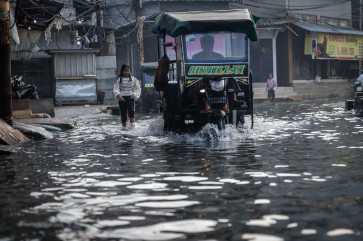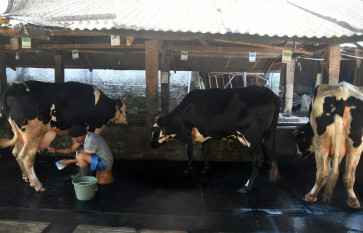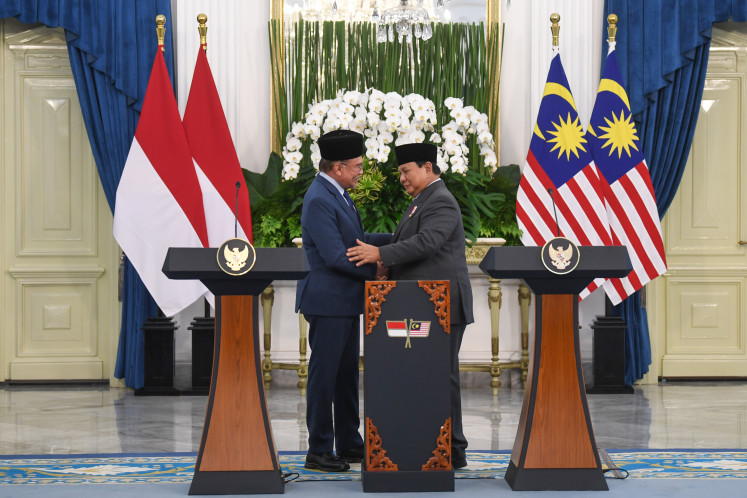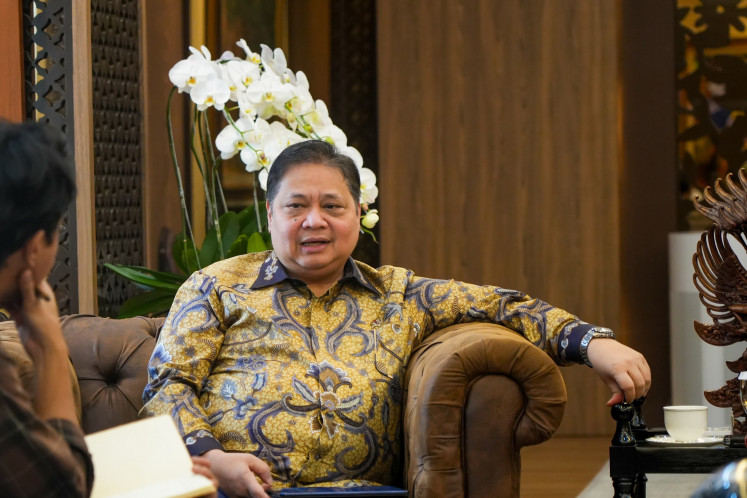Popular Reads
Top Results
Can't find what you're looking for?
View all search resultsPopular Reads
Top Results
Can't find what you're looking for?
View all search resultsIndonesian comic strips: Drowning but not dying
Educational too: A visitor browses the comic strips on display at the Comic Exhibition “Awaken Indonesian Comics”, held at the Library of the Jakarta National Education Department, from Dec
Change text size
Gift Premium Articles
to Anyone
E
span class="caption" style="width: 398px;">Educational too: A visitor browses the comic strips on display at the Comic Exhibition “Awaken Indonesian Comics”, held at the Library of the Jakarta National Education Department, from Dec. 1 to 12, 2009.
Witnessing the incident and without uttering a word, Adiguna immediately jumped up to release the garment Kencanawati had used to hang herself, shouldered Kencanawati’s slumped body, and took her away from the building filled with sinners. Kencanawati was now safe.
And so the story unfolded — or at least a snippet of it, featuring in Rondo Kuning, one of Yohanes’ comic strip on display at the comic exhibition “Awaken Indonesian Comics”.
The exhibition, held at the Library of the Jakarta National Education Department, from Dec. 1 to 12, 2009, showcased hundreds of comic book titles from various periods, by comic artists still producing work today.
Since the 1930s, comic books were mainly circulated in urban areas or upper class communities, where people could read and write. Kho Wang Gie, an artist of Chinese descent, became very popular in those days.
So much fun: The cover of a comic strip, featuring Jaka Sembung and Si Buta dari Gua Hantu, two characters originally created by Indonesian comic artists.
Over time, drawing comic strips became a means to publicize the fight against colonialists. Pictures of comic strip heroes were painted on walls, coupled with phrases that evoked a spirit of resistance. Although simple, the pictures were very easily understood by the average person, which was essential, because many people did not read or write at that time.
RA Kosasih and Oerip succeeded Kho Wang Gie as the next generation of comic artists in the 1950s. Stories were often based on puppet characters and became the main protagonists in comics.
Jan Mintaraga, Mansyur Jaman, Teguh Santosa and others took over as the 1960s generation of comic artists. And the genre has kept on growing until today. There are now hundreds of comic strip artists in Indonesia, such as Ganes TH, Koo Ping Hoo, Man, Hasmi, Wid NS, Djair, Gerdy WK, SH Mintardja, OKT, Gan KH, Arie and Ari Ardianto.
Iwan Gunawan, one of the comic book collectors, also the chairman of the Indonesian Comic Collector (Pengki), said that although some of the better-known works of Indonesian comic artists went in and out of fashion, they had been immortalized as part of the country’s history.
So how did comic strips flourish in Indonesia? It is said that Kho Wang Gie, initially a trader, became interested in drawing after seeing a comic strip when he opened a food wrap.
“It is unclear what the picture was. It was certainly from abroad, and soon after, Kho Wang Gie created Sri Asih, the first female superhero in the archipelago,” Iwan said.
Unfortunately, Indonesian comic strips never made it big in Indonesia or abroad. Comic strips from abroad were also allowed to enter the domestic market without restraint.
During the early rise of comics in the 1930s for example, the character Sri Asih had to fight against the onslaught of Superman, Tarzan and Wonder Woman comic strips, which were available at that time. “Fortunately, Sri Asih was able to survive,” Iwan said.
In the 1980s, Indonesian comic artists moved into the world of advertising, as the country did not have much of a homegrown entertainment industry. The only television channel was the government channel TVRI, and print media wasn’t too interested in introducing comics to its audiences.
“Indonesian comics never became mainstream like in the US, with Marvel or DC comics,” Iwan said.
No wonder then that Indonesia became a fertile market for the overseas comic industry. Japanese comics conquered the Indonesian market, with simple stories attracting larger audiences.
Indonesian comics became less and less popular, as other kinds of media took over, with a wider variety of television programs and TV cartoons. The rise of the Internet also hampered the development of Indonesian comics.
Is the Indonesian comic scene dying? Drowning, yes, but not quite dead yet. Amid the hurly-burly of manga and American comics, Indonesian comic artists are still working. Comic strip characters Koming, Timun, Bung Sentil, Bola, Benny and Mice, Sukribo, Kompopilan still appear in the mass media. And dozens of other characters still exist in the comic book form.
Go Indonesia!: The cover of an Indonesian comic strip about Gundala, Putera Petir, or Gundala, the boy of thunder.
Gerdy W. K., one of Indonesia’s comic artists, explained how difficult it was to make a living from that profession today. Society’s entertainment values have changed with the presence of many different media outlets.
“The choice is working as a cartoonist or working for other people. The ideal situation is cartooning
and doing other work part-time,” Gerdy said.
Once the cartoon is completed, artists still need to find a media outlet that will publish their artwork. And publishers have recently started to be very selective.
“Their market standards are clear. Therefore comic artists should pay close attention to the needs of publishers and demands of comic strip readers.”
Fortunately, there are a number of comic strip fan communities in Indonesia, for example the Indonesian Comic Collector (Pengki) and the Indonesian Comic Publisher Community (KPKI).
There are also alternative comic strip communities scattered in many cities across Indonesia, which publish domestic comics in black and white and encourage upcoming comic artists.
Beng Rahardian, one of the young comic artists who is also one of the founders of the Samali Academy, is said to be one of the pioneers when it comes to educating Indonesians about comics.
At the Samali College, community members can learn visual and narrative art skills, like pictures, photography, comics and script development. Beng and his community regularly attend various themed comic events held throughout Indonesia. The community recently produced a comic book titled My Love, featuring on Facebook.
Although Indonesia’s comic strip industry could be doing better, its educational role has not changed. The language of comics and their images have become an effective way to transform the contents of educational material.
Yus Mawardi, the head of information at the department of education, said the educational role of comics strips made the government feel the need to help Indonesian comic artists.
“The exhibition is one way we are providing support,” Mawardi said.
A workshop titled “Comics for Everyday” was also held at the CerGam Center, specifically for children and adolescents (aged between 9 and 18 years old).
Between Feb. 26 and 28, 2010, an Indonesian Comics Festival will be held at Pasar Festival in Kuningan, Jakarta. The Indonesian Comics Festival will be an excellent celebration of comics with the theme “Dare to read a comic!”
So what are you waiting for? Rise up for Indonesian comics!
— Photos by ID Nugroho












